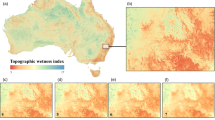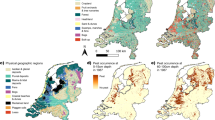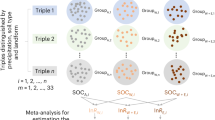Abstract
Soil organic carbon (C) is an essential component of the global C cycle. Processes that control its composition and dynamics over large scales are not well understood. Thus, our understanding of C cycling is incomplete, which makes it difficult to predict C gains and losses due to changes in climate, land use and management. Here we show that controls on the composition of organic C, the particulate, humus and resistant fractions, and the potential vulnerability of C to decomposition across Australia are distinct, scale-dependent and variable. We used machine-learning with 5,721 topsoil measurements to show that, continentally, the climate, soil properties (for example, total nitrogen and pH) and elevation are dominant controls. However, we found that such general assessments disregard underlying region-specific controls that affect the distribution of the organic C fractions and vulnerability. This can lead to misinterpretations that prejudice our understanding of soil C processes and dynamics. Regionally, climate is mediated through interactions with soil properties, mineralogy and topography. In some regions, climate is uninfluential. These results highlight the need for regional assessments of soil C dynamics and more local parameterization of biogeochemical and Earth system models. Our analysis propounds the development of region-specific strategies for effective C management and climate change mitigation.
This is a preview of subscription content, access via your institution
Access options
Access Nature and 54 other Nature Portfolio journals
Get Nature+, our best-value online-access subscription
$29.99 / 30 days
cancel any time
Subscribe to this journal
Receive 12 print issues and online access
$259.00 per year
only $21.58 per issue
Buy this article
- Purchase on Springer Link
- Instant access to full article PDF
Prices may be subject to local taxes which are calculated during checkout




Similar content being viewed by others
Data availability
The data sets generated during and/or analysed during the current study are not publicly available but are available from the corresponding author on reasonable request. The digital soil maps of the particulate, humus and resistant fractions are available for download from https://doi.org/10.25919/5ca56d1d0166b.
Code availability
The code used for the machine-learning modelling is available from the corresponding author on reasonable request.
References
Batjes, N. H. Total carbon and nitrogen in the soils of the world. Eur. J. Soil Sci. 47, 151–163 (1996).
Trumbore, S. E., Chadwick, O. A. & Amundson, R. Rapid exchange between soil carbon and atmospheric carbon dioxide driven by temperature change. Science 272, 393–396 (1996).
Baisden, W. T. & Amundson, R. An analytical approach to ecosystem biogeochemistry modeling. Ecol. Appl. 13, 649–663 (2003).
Jackson, R. B. et al. The ecology of soil carbon: pools, vulnerabilities, and biotic and abiotic controls. Annu. Rev. Ecol. Evol. Syst. 48, 419–445 (2017).
Davidson, E. A. & Janssens, I. A. Temperature sensitivity of soil carbon decomposition and feedbacks to climate change. Nature 440, 165–173 (2006).
Jenkinson, D. S. The turnover of organic carbon and nitrogen in soil. Phil. Trans. R. Soc. Lond. B 329, 361–368 (1990).
Parton, W. J., Schimel, D. S., Cole, C. V. & Ojima, D. S. Analysis of factors controlling soil organic matter levels in Great Plains grasslands. Soil Sci. Soc. Am. J. 51, 1173 (1987).
Six, J., Conant, R. T., Paul, E. A. & Paustian, K. Stabilization mechanisms of soil organic matter: implications for C-saturation of soils. Plant Soil 241, 155–176 (2002).
Smith, J. U., Smith, P., Monaghan, R. & MacDonald, J. When is a measured soil organic matter fraction equivalent to a model pool? Eur. J. Soil Sci. 53, 405–416 (2002).
Krull, E. S., Baldock, J. A. & Skjemstad, J. O. Importance of mechanisms and processes of the stabilisation of soil organic matter for modelling carbon turnover. Funct. Plant Biol. 30, 207 (2003).
Trumbore, S. Age of soil organic matter and soil respiration: radiocarbon constraints on belowground C dynamics. Ecol. Appl. 10, 399–411 (2000).
Skjemstad, J. O., Spouncer, L. R., Cowie, B. & Swift, R. S. Calibration of the Rothamsted organic carbon turnover model (RothC ver. 26.3), using measurable soil organic carbon pools. Aust. J. Soil Res. 42, 79–88 (2004).
von Lutzow, M. et al. SOM fractionation methods: relevance to functional pools and to stabilization mechanisms. Soil Biol. Biochem. 39, 2183–2207 (2007).
Zimmermann, M., Leifeld, J., Schmidt, M. W., Smith, P. & Fuhrer, J. Measured soil organic matter fractions can be related to pools in the RothC model. Eur. J. Soil Sci. 58, 658–667 (2007).
Baldock, J. A. et al. Quantifying the allocation of soil organic carbon to biologically significant fractions. Soil Res. 51, 561–576 (2013).
Lehmann, J. & Kleber, M. The contentious nature of soil organic matter. Nature 528, 60–68 (2015).
O’Rourke, S. M., Angers, D. A., Holden, N. M. & McBratney, A. B. Soil organic carbon across scales. Glob. Change Biol. 21, 3561–3574 (2015).
Isbell, R. F. The Australian Soil Classification Revised 1st edn (CSIRO Publishing, 2002).
DAFF Land use of Australia, version 4, 2005–06 dataset (Australian Government Department of Agriculture, Fisheries and Forestry, 2010); http://data.daff.gov.au/anrdl/metadata_files/pa_luav4g9abl07811a00.xml
Amundson, R. & Jenny, H. On a state factor model of ecosystems. BioScience 47, 536–543 (1997).
Vitousek, P. M. in Factors of Soil Formation: a 50th Anniversary Retrospective (eds Amundson, R., Harden, J. & Singer, M.) 87–97 (Soil Science Society of America Special Publication 33, 1994).
Quinlan, J. R. In Proc. AI’92, 5th Australian Conference on Artificial Intelligence (eds Adams, A. & Sterling, L.) 343–348 (World Scientific, 1992).
Baldock, J. A. et al. Australian Soil Carbon Research Program. Data Collection v1 (CSIRO, 2013); https://doi.org/10.4225/08/5101F31440A36
Hutchinson, M. F. et al. Integrating a global agro-climatic classification with bioregional boundaries in Australia. Glob. Ecol. Biogeogr. 14, 197–212 (2005).
Wynn, J. G. et al. Continental-scale measurement of the soil organic carbon pool with climatic, edaphic, and biotic controls. Glob. Biogeochem. Cycles 20, GB1007 (2006).
Hobley, E., Wilson, B., Wilkie, A., Gray, J. & Koen, T. Drivers of soil organic carbon storage and vertical distribution in Eastern Australia. Plant Soil 390, 111–127 (2015).
Luo, Z., Feng, W., Luo, Y., Baldock, J. & Wang, E. Soil organic carbon dynamics jointly controlled by climate, carbon inputs, soil properties and soil carbon fractions. Glob. Change Biol. 23, 4430–4439 (2017).
Manzoni, S. & Porporato, A. Soil carbon and nitrogen mineralization: theory and models across scales. Soil Biol. Biochem. 41, 1355–1379 (2009).
Bradford, M. A. et al. Managing uncertainty in soil carbon feedbacks to climate change. Nat. Clim. Change 6, 751–758 (2016).
Todd-Brown, K. E. O. et al. Changes in soil organic carbon storage predicted by Earth system models during the 21st century. Biogeosciences 11, 2341–2356 (2014).
Davidson, E. A., Savage, K. E. & Finzi, A. C. A big-microsite framework for soil carbon modeling. Glob. Change Biol. 20, 3610–3620 (2014).
Kuzyakov, Y., Friedel, J. K. & Stahr, K. Review of mechanisms and quantification of priming effects. Soil Biol. Biochem. 32, 1485–1498 (2000).
Lajtha, K. et al. Changes to particulate versus mineral-associated soil carbon after 50 years of litter manipulation in forest and prairie experimental ecosystems. Biogeochemistry 119, 341–360 (2014).
Jenkinson, D. S., Adams, D. E. & Wild, A. Model estimates of CO2 emissions from soil in response to global warming. Nature 351, 304–306 (1991).
Lal, R. Soil health and carbon management. Food Energy Secur. 5, 212–222 (2016).
Smith, P. et al. Greenhouse gas mitigation in agriculture. Phil. Trans. R. Soc. B 363, 789–813 (2008).
Ogle, S. M., Breidt, F. J. & Paustian, K. Agricultural management impacts on soil organic carbon storage under moist and dry climatic conditions of temperate and tropical regions. Biogeochemistry 72, 87–121 (2005).
Lal, R. Beyond COP21: potential and challenges of the ‘4 per thousand’ initiative. J. Soil Water Conserv. 71, 20A–25A (2016).
Baldock, J. A., Hawke, B., Sanderman, J. & Macdonald, L. M. Predicting contents of carbon and its component fractions in Australian soils from diffuse reflectance mid-infrared spectra. Soil Res. 51, 577–595 (2013).
Sanderman, J. et al. National Soil Carbon Research Programme: Field and Laboratory Methodologies (CSIRO Land and Water, 2011).
Viscarra Rossel, R. A. & Hicks, W. S. Soil organic carbon and its fractions estimated by visible-near infrared transfer functions. Eur. J. Soil Sci. 66, 438–450 (2015).
de Caritat, P., Lech, M. E. & McPherson, A. A. Geochemical mapping ‘down under’: selected results from pilot projects and strategy outline for the National Geochemical Survey of Australia. Geochem. Explor. Environ. Anal. 8, 301–312 (2008).
Johnston, R. M. et al. ASRIS: the database. Soil Res. 41, 1021–1036 (2003).
McKenzie, N. J. & Cresswell, H. P. in Soil Physical Measurement and Interpretation for Land Evaluation (eds McKenzie, N. J., Coughlan, K. J. & Cresswell, H. P.) (CSIRO, 2002).
Skjemstad, J. O., Clarke, P., Taylor, J. A., Oades, J. M. & McClure, S. G. The chemistry and nature of protected carbon in soil. Aust. J. Soil Res. 34, 251–271 (1996).
Smernik, R. J. & Oades, J. M. The use of spin counting for determining quantitation in solid state 13C NMR spectra of natural organic matter. 1. Model systems and the effects of paramagnetic impurities. Geoderma 96, 101–129 (2000).
Smernik, R. J. & Oades, J. M. The use of spin counting for determining quantitation in solid state 13C NMR spectra of natural organic matter. 2. HF-treated soil fractions. Geoderma 96, 159–171 (2000).
Jobbágy, E. G. & Jackson, R. B. The vertical distribution of soil organic carbon and its relation to climate and vegetation. Ecol. Appl. 10, 423–436 (2000).
Bartels, R. H., Beatty, J. C. & Barsky, B. A. An Introduction to Splines for Use in Computer Graphics and Geometric Modeling (Morgan Kaufmann, 1987).
Viscarra Rossel, R. A. & Webster, R. Predicting soil properties from the Australian soil visible–near infrared spectroscopic database. Eur. J. Soil Sci. 63, 848–860 (2012).
Akaike, H. A new look at the statistical model identification. IEEE Trans. Autom. Control 19, 716–723 (1974).
Lin, L. I.-K. A concordance correlation coefficient to evaluate reproducibility. Biometrics 45, 255–268 (1989).
Kuhn, M. Building predictive models in R using the caret package. J. Stat. Softw. 28, 1–26 (2008).
R Core Team. R: A Language and Environment for Statistical Computing. (R Foundation for Statistical Computing, 2018).
Hastie, T., Tibshirani, R. & Friedman, J. The Elements of Statistical Learning: Data Mining, Inference and Prediction (Springer, 2009).
Zhou, X.-H. & Gao, S. Confidence intervals for the log-normal mean. Stat. Med. 16, 783–790 (1997).
Viscarra Rossel, R., Webster, R., Bui, E. & Baldock, J. Baseline map of organic carbon in Australian soil to support national carbon accounting and monitoring under climate change. Glob. Change Biol. 20, 2953–2970 (2014).
Viscarra Rossel, R. A. et al. The Australian three-dimensional soil grid: Australia’s contribution to the GlobalSoilMap project. Soil Res. 53, 845–864 (2015).
Acknowledgements
We thank the Australian Government Department of the Environment and Energy for funding work, as part of their progressing improvements of the FULLCAM model and the National Greenhouse Gas Inventory System, which led to the development of this research. We also thank S. Tuomi, P. Leppert, M. Virueda and G. Navarrette for their help with the spectroscopic measurements. We thank SCaRP for the collection of soil samples and their analysis. SCaRP was funded by the Climate Change Research Program of the Australian Department of Agriculture and the Grains Research and Development Corporation. We also thank the NGSA team and Geoscience Australia for the sampling, preparation and provision of the NGSA samples.
Author information
Authors and Affiliations
Contributions
R.A.V.R. conceived the work, and led and performed the data analyses, interpretations and writing, J.L. and T.B. contributed to the data analysis, interpretations and writing, Z.L. contributed to the interpretations and writing, J.B. and A.R. contributed data and to the editing of the first draft.
Corresponding author
Ethics declarations
Competing interests
The authors declare no competing interests.
Additional information
Publisher’s note: Springer Nature remains neutral with regard to jurisdictional claims in published maps and institutional affiliations.
Supplementary information
Supplementary Information
Supplementary Description, Supplementary Figs. 1–6 and Tables 1–6.
Rights and permissions
About this article
Cite this article
Viscarra Rossel, R.A., Lee, J., Behrens, T. et al. Continental-scale soil carbon composition and vulnerability modulated by regional environmental controls. Nat. Geosci. 12, 547–552 (2019). https://doi.org/10.1038/s41561-019-0373-z
Received:
Accepted:
Published:
Issue Date:
DOI: https://doi.org/10.1038/s41561-019-0373-z
This article is cited by
-
A warming climate will make Australian soil a net emitter of atmospheric CO2
npj Climate and Atmospheric Science (2024)
-
Depth-Dependent Controls Over Soil Organic Carbon Stock across Chinese Shrublands
Ecosystems (2023)
-
Role of environmental factors on concentrations and ratios of subsoil C–N–P in subtropical paddy fields
Journal of Soils and Sediments (2023)
-
Current controversies on mechanisms controlling soil carbon storage: implications for interactions with practitioners and policy-makers. A review
Agronomy for Sustainable Development (2023)
-
Multi-scale mapping of Australia’s terrestrial and blue carbon stocks and their continental and bioregional drivers
Communications Earth & Environment (2023)



